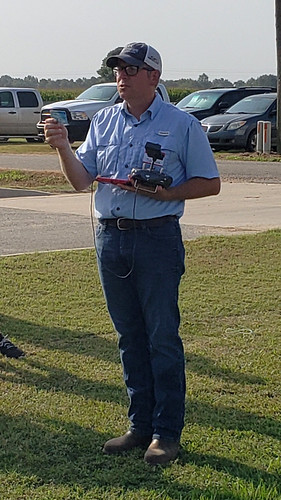Rohwer Field Day: Unraveling the mysteries of taproot decline; use of ag drones
July 24, 2018
By Mary Hightower
U of A System Division of Agriculture
Fast Facts:
- Taproot decline mystery unraveled by pathologists in Arkansas, Louisiana, Mississippi
- Field day offered tour stops on drone use, management practices in multiple commodities.
(605 words)
(Newsrooms: with art and video at https://flic.kr/s/aHsmpuKMdx )
Download Word version
ROHWER, Ark. – Superb sleuthing among plant pathologists in three states helped track down the culprit whose symptoms included soybean seedling death, yellow leaves and lower yields.
Taproot decline, a disease first noticed in Arkansas, Louisiana and Mississippi in 2007 and formally identified in 2017, was one of the topics on the agenda during the 2018 Rohwer Field Day hosted by the University of Arkansas System Division of Agriculture. More than 100 growers, consultants, extension personnel and researchers weathered the southeast Arkansas heat and humidity for the event.

Terry Spurlock, associate professor and extension plant pathologist for the Division of Agriculture, discussed variety trials at Rohwer, to see which of the soybeans could tolerate or resist the fungal infection. It was one of two presentations he gave during the field day. His other presentation covered the use of drones, or unmanned aircraft systems in agriculture.
Spurlock said Division of Agriculture scientists banded together with colleagues at LSU and Mississippi State to uncover the mystery that was damaging soybeans.
“We did all the work between the three institutions. The disease is caused by a fungus that had never been described before,” Spurlock said. “It wasn’t in any of the DNA databases.”
Eventually, the pathologists found that the as yet-unnamed fungus was a Xylaria, known as wood-rotting fungus that produces “dead man’s fingers” commonly seen in forests. When the fungus infects onto a soybean seeding, it causes the taproot to rot and kills its young host plant. “Infections of more mature soybean cause symptoms such as stunting, severe chlorosis and yield loss,” he said.
“Taproot decline is a disease of increasing importance to Arkansas,” he said. At the field day, “I was telling farmers about how bad it’s gotten. It’s been as bad this year as it’s ever been.”
The disease has been found predominantly in southeastern Arkansas and as far north as Missouri and Tennessee and was also found in Alabama last year.
With the variety trials, “we were looking at commercial varieties to not only determine which are susceptible, but also to see some that might have some tolerance or resistance to this disease that we can recommend to growers,” he said. During the field day, “we had plenty to show from the fields; a good plot versus one ravaged by disease. It was a good day. “
Spurlock said the “trials are being done in triplicate in Louisiana and Mississippi and Arkansas. We’ll put all the data together at the end of the year. We’ll have that data by the winter production meetings.”
The research on taproot decline is being supported by soybean promotion boards in all three states.
Ag drones
Spurlock and Larry Purcell, distinguished professor-Crop, Soils and Environmental Science for the Division of Agriculture, each held talks about drone use in the field.
“What we were trying to accomplish with that demonstration was to introduce them to a good entry level ‘commercial grade’ UAV that would provide them useable data for their particular farm; one that’s durable and versatile, as well as address limitations,” Spurlock said.
Spurlock demonstrated with a DJI Phantom 4 to “show how they operated and what their expectations for data output would be.”
He also fielded questions about what certifications were required to operate a drone legally on a commercial operation – even if it was the pilot’s own land. Spurlock and Purcell also showed growers how easy drones were to fly.
Spurlock used the Precision Flight app from Precision Hawk to let the drone fly itself. The app allows the pilot to set boundaries for the drone and the drone figures out its own flight path within the boundaries.
“You don’t have to do anything,” he said. “You’re not touching a joystick or a hand controller unless you absolutely have to, like if you see a plane coming and you need to land it now.”
The field day tours also included soil fertility, nitrogen management and reduction of herbicide stress in rice; potassium management in cotton on Delta soils and high yield practices in corn and grain sorghum.
For more information on ag production techniques, contact your county extension office or visit www.uaex.uada.edu.
Mention of commercial names does not imply endorsement by the University of Arkansas System Division of Agriculture.
About the Division of Agriculture
The University of Arkansas System Division of Agriculture’s mission is to strengthen agriculture, communities, and families by connecting trusted research to the adoption of best practices. Through the Agricultural Experiment Station and the Cooperative Extension Service, the Division of Agriculture conducts research and extension work within the nation’s historic land grant education system.
The Division of Agriculture is one of 20 entities within the University of Arkansas System. It has offices in all 75 counties in Arkansas and faculty on five system campuses.
Pursuant to 7 CFR § 15.3, the University of Arkansas System Division of Agriculture offers all its Extension and Research programs and services (including employment) without regard to race, color, sex, national origin, religion, age, disability, marital or veteran status, genetic information, sexual preference, pregnancy or any other legally protected status, and is an equal opportunity institution.
# # #
Media Contact: Mary Hightower
Dir. of Communication Services
U of A System Division of Agriculture
Cooperative Extension Service
(501) 671-2126
mhightower@uada.edu